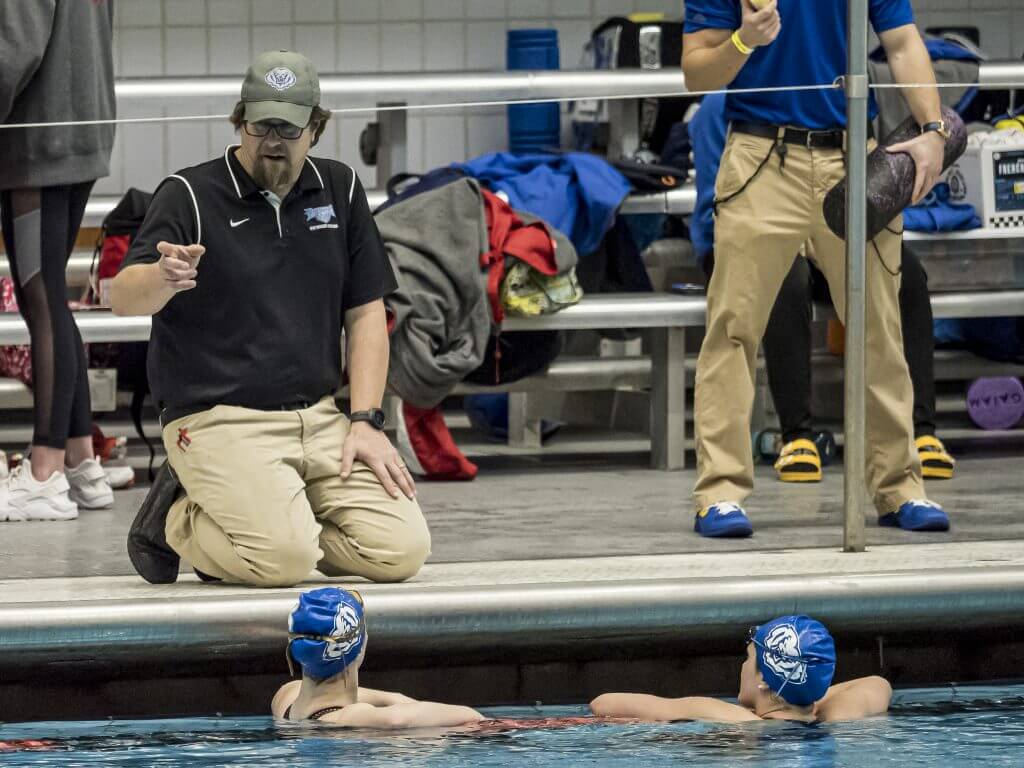High School and Club Coach Relationships: An Intricate Balance

High School and Club Coach Relationships: An Intricate Balance
The high school/club coach relationship: Collegial or fire-and-ice? Google the subject today, and you will find the full fury of both sides and an occasional voice of reason. The debate—or polarization—can range from harmony and synergy to petitions, lawsuits and athletes withdrawing from one of the two teams.
Consider the following scenario: On the high school side, you may hear the coach say, “Welcome to the 2023 high school season. Here are the requirements: You have to be at workout six out of seven sessions, or you are not on the team.” The club kids look around and ask, “Does that apply to us?” And the coach goes, “Yeah, if you want to be on the team.” And then it spirals out of control. Parents get involved, coaches get mad, and kids get confused.
The extreme perspective on the club side is: “I don’t care about your high school team. This is where you train, you can’t miss a workout. Tell the high school coach if he/she wants you on the team, you’ll be at the meets…maybe.” Again, “The result is that kids who want to be with their high school friends are stuck in the middle,” says a veteran high school and club coach.
DIFFERENT STROKES
One dynamic that muddies the water is that states have different in-season rules for high school swimming participation. Some, like Texas (for the most part), Illinois and Minnesota, require athletes to compete and train exclusively for one or the other. Some states, Virginia, for example, allow athletes to compete in both USA Swimming and high school meets during their designated season. Others, notably California, have varying degrees of restrictions regarding same-season club and high school participation. That variability goes to the center of the issue.
THE MIDDLE GROUND

George Block – Photo Courtesy: San Antonio Sports
But it doesn’t have to be that way. In 2004, George Block, former president of ASCA and future vice president of USA Swimming and president of the World Swimming Coaches Association, authored a white paper on the subject. In it, he cited communication, continuity and respect as the guiding principles for club/high school coach harmony. In the last 19 years, nothing has changed to alter that winning formula.
Graham Westerberg is athletic director at the Holton-Arms School in Bethesda, Md. For nearly 20 years, he coached a very successful girls’ program whose roster included club-trained swimmers. “Any time, as a high school or club coach, if you have the best interests of the athlete in mind, that’s a recipe for success.
“In my long tenure of high school coaching, there were some coaches who were phenomenal. We would develop relationships, talk constantly and make sure we were doing what was best for that particular swimmer. Of my club swimmers, I required one practice with us once a week and attendance at all meets and team functions. That gave leeway for big club meets—and I expected reciprocation.”
Westerberg admits that give-and-take was the fabric of the relationship, and “those actions seemed to be the best at keeping a swimmer on top. Communication was absolutely the key,” he says.
When things didn’t work, “it was because people got selfish: ‘My swimmers should be with me every day!’ That approach really impacts a high school coach who is trying to develop a team. That’s where the club world is different. It’s a team, but it’s a different team. You want to bring people together, but when they are not around, it’s hard to do.”
OLD SCHOOL
 Mark Onstott, nine years retired from New Trier High School, was a multi-time president of NISCA, won seven boys’ Illinois high school state championships and assisted with six girls’ titles. He also steered his boys to one overall Swimming World mythical national championship and another for public schools. In his 40-plus-year career, he coached high school swimming in Iowa, Texas and Illinois, working with similarly accomplished high school coaches.
Mark Onstott, nine years retired from New Trier High School, was a multi-time president of NISCA, won seven boys’ Illinois high school state championships and assisted with six girls’ titles. He also steered his boys to one overall Swimming World mythical national championship and another for public schools. In his 40-plus-year career, he coached high school swimming in Iowa, Texas and Illinois, working with similarly accomplished high school coaches.
His best experiences were working in concert with club coaches rather than ones who displayed an air of superiority and discounted the coaching skills of secondary school counterparts. His real bone of contention with club coaches was with those “who were dishonest with me, didn’t honor agreements made or injected doubt in the minds of swimmers I was coaching,” he says.
Where relations were not strained was when he, the New Trier’s girls’ coach and a club coach met weekly to discuss swimmers and what workouts were being done. “When we did that, it was great.” It helped, he notes, that the coaches were not sharing swimmers during the same competition period.
ANOTHER VOICE
Mike Koleber, ASCA board member and head coach of Nitro Swimming in Bee Cave, Texas, has a measured view of the club/high school coach discussion: “As club coaches at Nitro, we don’t care what cap the athletes are wearing at whatever championship meet they have determined to be their main priority. If it is high school divisionals, regionals, state, and they are wearing their high school team cap representing their high school team, awesome. If they have chosen to make sectionals, futures or juniors their focus and they will be wearing our Nitro cap, then we’re cool with that, too. We will do our best to prepare them to the best of our ability for whatever meet they have decided is their main focal point.
“Personally, I think every ninth- or tenth-grader—depending on when their first year of high school begins—should give high school swimming a fair shot. There is something really special about weekly meets, wearing your school’s colors/sweats, getting your name spoken on the morning announcements and belonging to something bigger than yourself—especially as an underclassman. Once they’ve given it their best in that first year, they can then decide what’s best for their long-term swim goals for the ensuing years of high school.
“There are some high school coaches who like to work in alignment with club coaches. And there are some club coaches who reciprocate. However, we all know stories of where that relationship doesn’t exist. The club coach takes an all-or-nothing stand, and/or the high school coach does the same. That is certainly their prerogative, but ultimately, it puts the athlete in between, and that doesn’t help matters much.
“A number of years ago, one of our area high school coaches had the all-or-nothing approach—mandatory 100% attendance in a group of 40+ swimmers with 100 freestyle times ranging from 45 or so north of 1:30. No assistant. Our juniors qualifiers were having to miss our a.m.’s with filming, resistance training, similarly grouped high-level swimmers, season plan, etc., so they could still enjoy their high school swimming experience.
“A group of our parents who were also part of that high school drafted a letter to the athletic director and asked me to put my name on the bottom of the letter and to join them in meeting with the AD. I did not sign because I believe high school coaches have the right to run their programs however they want. I’m not getting in the middle of it. Eventually the kids will decide what is best for them.
“In this particular case, several swimmers quit the high school team. Ultimately, the coach adjusted the requirements to a more balanced approach that allowed the higher-level kids to swim most mornings with us. I’d rather have harmony over discord. The market will sort itself out if given time. The most successful high school/club relationships I see are the ones where there is a little give-and-take and mutual respect shown by both parties,” says Koleber.
FROM THE ASHES
Time was when Norfolk Academy teams dominated the Virginia independent high school swimming and diving championships, winning 15 state titles in 10 years. In the ensuing 24 years under a coach who insisted club swimmers train exclusively with him, the Bulldogs were not as successful.

Photo Courtesy:
In 2018 under new coaches Joel Shinofield (head man at Washington and Lee University, later executive director of the CSCAA and managing director of sport development at USA Swimming) and Kristen Kirkman, longtime coach at ODAC, that first season brought a period of relationship building with area club coaches.
Bottom line: a new lease on life for Norfolk Academy swimming. Witness finishes over the next five years for the girls’ team of second/first/fourth/second/third; and the boys, first/first/fifth/third/third. In visiting club coaches, Shinofield came to an agreement on schedules and training parameters—tapering, etc.—that worked for swimmers and coaches alike.
“It was great because we had kids in school since first grade who’d never been on the team,” he says. A prime example was Callie Dickinson. In her only year on the team, she was a four-time NISCA All-American and three-time state champion. She then matriculated to Georgia, earned seven CSCAA A-A citations and was named SEC Scholar-Athlete for 2023.
“Establishing the relationships wasn’t that hard,” says Shinofield. However, “change was hard, as some worried that club kids were going to take all the relay spots. That didn’t happen. We had a girls’ state championship 200 free relay team that included a rower and a top tennis player with two club swimmers. The fun part was convincing kids and parents that everyone would be better together.
“That’s the beauty—we’re good because of the sum of the parts. It’s how you assemble them. A good coach looks at what’s good for the kids. If you work backward from there, you get a good result,” he says. “Frankly, having kids swim high school and getting recognition for it is good for our sport.”
A BALANCE
Don Heidary, World Swimming Coaches Association board member and veteran high school (Miramonte) and club coach (Orinda) in northern California, has seen it all: the good, the bad and the positive compromise.
“The club/high school relationship is one of the most complex in swimming,” he says. “While it may seem insignificant or a mere scheduling issue on the surface, this dynamic can range from a spirited experience to a highly contentious one.
“And beyond the overt experience are the substantive issues of athlete training continuity and the very culture of a high school program. For the club swimmer, it is three months of training—times four years! For the club team, it can potentially be a loss of membership and revenue. For the high school program, it can be the difference between mediocre programs or conference or state titles.
“Regardless of perspective, it is a delicate balance. There are arguments—literally—on both sides…and they create an inherent push-pull dynamic, leaving the athlete in the middle.
“This is not always simply a ‘just do what is in the best interest of the athlete.’ That’s because what is in the best interest of the athlete may not be in the best interest of the high school program. While there is no ‘clean’ solution, there is a workable pathway—as I have observed and executed for 30-plus years—if each side is willing to work with the other. Of course, there are high school coaches who simply don’t care when club swimmers are at workout, only if they compete, i.e., score. While this does eliminate conflict, it presents a host of other cultural issues.
“But in situations where both sides want, or require, the athlete in attendance, the best medium is a one-third/two-third split. The athlete spends the majority of their time training with the club and attends one or two workouts a week, plus necessary competition, meetings and activities with the high school team.
“This tends to allow the club swimmer to maintain training continuity, albeit not ideal, yet connect with the high school program. And from this starting point, there are many variations. The keys are that an athlete’s year-round commitment should be respected—not disregarded—by the high school coach. A club athlete wanting to represent their high school should do so to the degree that the high school is willing and flexible.
“The time a club athlete spends with a high school program should be with the intent to support, lead and inspire high school athletes. All club swimmers should represent the pinnacle of the sport, with a leadership mindset of being a great teammate, mentor or role model.
“Absent this mindset and intent, club swimmers can appear distant, elitist—i.e., better than—and uncaring, which can create a negative stereotype not conducive to relationship building. With compromise and positive engagement, the relationship can be—and should be—win-win,” says Heidary.
Michael J. Stott is an ASCA Level 5 coach, golf and swimming writer. His critically acclaimed coming-of-age golf novel, “Too Much Loft,” is in its third printing, and is available from store.Bookbaby.com, Amazon, B&N and book distributors worldwide.




I know about the conflict between girls’ high school basketball and travel volleyball. Travel team coaches are paid 10 times more than high school coaches. Money talks. I cover a lot in practices. Miss a practice and you hurt the team. Miss travel ball and coaches lose money. They put lots of pressure on the girls to give up basketball.